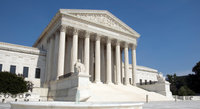U.S. Supreme Court Opposes Unions in Harris V. Quinn Ruling.
The U.S. Supreme Court’s conservative majority dealt a major blow to organized labor this week in its 5-4 vote on Harris v. Quinn, ruling that home healthcare workers in the state of Illinois no longer have to pay fair share fees to unions they opt out of but are still reaping the rewards from—like collective bargaining on their behalf.
As one of 26 states that require public-sector employees to pay fair share or “agency” fees to unions they decide not to join, Illinois could now face further setbacks as the momentum ofHarris v. Quinn sets a precedent for future cases. While the ruling of this particular case doesn’t affect AFSCME Council 13 and its members currently, the U.S. Supreme Court could rule in the future that no labor organization representing public-sector workers has the right to collect fair shares from anyone who opts out of the union. The impact of such a decision would be devastating to organized labor across the country.
The Justices decided not to include “full-fledged” public-sector employees in their ruling, only home healthcare workers partially funded by the state via Medicaid. These employees are also paid by the individuals receiving care who wield the power to hire and fire. Because of the ruling, these employees may take advantage of the union’s grievance procedures and collective bargaining mechanisms without having to contribute monies in the traditional membership fashion.
Unions rely on the fees collected from its membership to remain operational, so giving employees the option to enjoy the benefits of belonging to a union without contributing to one is not a sustainable formula. Home healthcare workers belonging to Service Employees International Union (SEIU), AFSCME and American Federation of Teachers (AFT) across states like Illinois, California, Connecticut and many others, can now decide not to financially support the union that negotiates contracts that addresses concerns they share with the rest of the union community.
Like a public radio listener that enjoys the programs that it has to offer while never contributing to its fundraising campaigns, these “freeloaders” now have the ability to strip funding to an organization they technically belong to, perhaps even unintentionally. Instead of mandating the collection of fair share fees from these individuals, it is now the burden of the union to convince these wary employees that joining the union is the way to go. Unions engage in this kind of behavior daily but could be allocating resources elsewhere if fair share fees remain intact.
Fears of national repercussions are warranted; Justice Alito vocalized his dissent of Abood v. Detroit Board of Education, which in 1977 established so-called “fair share fees” as a legal means for unions to collect dues, in his Harris v. Quinn majority opinion. In it, he claims the ruling which has allowed AFSCME and others to collect fees from non-participating employees, is “questionable.” The tonality of his opinion suggests that Abood may be overturned at a later court session.
While the Obama Administration has publically opposed the recent ruling, it’ll take more than those in the White House to overcome a conservative U.S. Supreme Court determined to destabilize unions once and for all.

The front of the US Supreme Court in Washington, DC.
Completed in 1935, the US Supreme Court building in Washington, DC, is the first to have been built specifically for the purpose, inspiring Chief Justice Charles Evans Hughes to remark, ÒThe Republic endures and this is the symbol of its faith.Ó
The Court was established in 1789 and initially met in New York City. When the national capital moved to Philadelphia, the Court moved with it, before moving to the permanent capital of Washington, DC, in 1800. Congress lent the Court space in the new Capitol building, and it was to change its meeting place several more times over the next century, even convening for a short period in a private house after the British set fire to the Capitol during the War of 1812.
The classical Corinthian architectural style was chosen to harmonize with nearby congressional buildings, and the scale of the massive marble building reflects the significance and dignity of the judiciary as a co-equal, independent branch of government.
The main entrance is on the west side, facing the Capitol. On either side of the main steps are figures sculpted by James Earle Fraser. On the left is the female Contemplation of Justice. On the right is the male Guardian or Authority of Law. On the architrave above the pediment is the motto ÒEqual Justice under Law.Ó Capping the entrance is a group representing Liberty Enthroned, guarded by Order and Authority, sculpted by Robert Aitken.
At the east entrance are marble figures sculpted by Hermon A. MacNeil. They represent great law givers Moses, Confucius, and Solon, flanked by Means of Enforcing the Law, Tempering Justice with Mercy, Settlement of Disputes between States, and Maritime and other functions of the Supreme Court. The architrave carries the motto ÒJustice the Guardian of Liberty.Ó
The interior of the building is equally filled with symbolic ornamentation. The main corridor is known as the Great Hall and contains double rows of marble columns
